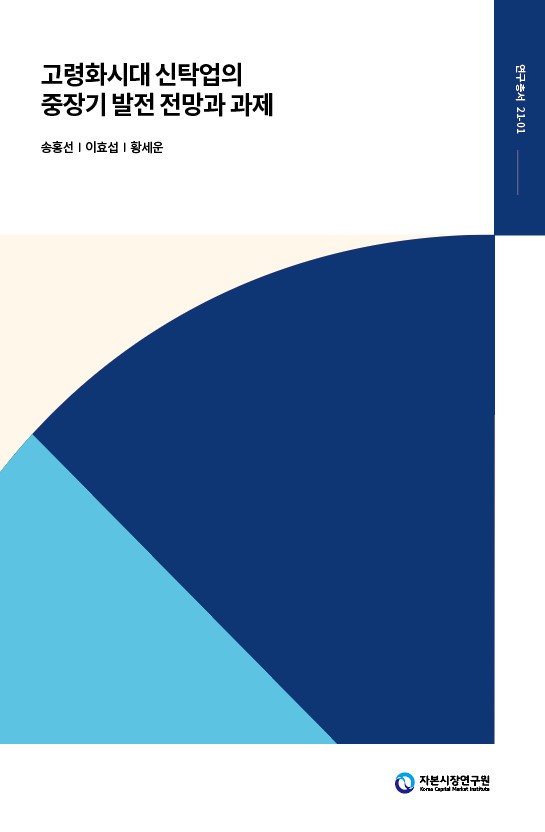Find out more about our latest publications

Overhauling Korea’s Trust Service Industry in the Era of Rapid Aging
Research Series 21-01 Feb. 03, 2021
- Research Topic Asset Management/Pension
- Page 212
Reshaping Korea’s Trust Service Industry in the Era of Rapid Aging
This paper is purposed to come up with plans to develop Korea’s trust service industry, based on a comparative look at the regulatory framework across Korea and other nations including Japan and the US including a series of largely economic analyses on the industry’s current status, problems, and future potential. The results confirm the stalling growth of Korea’s trust service industry. Also found is Korea’s future growth potential in terms of both the absolute and relative sizes, both of which suggest ample opportunities of the industry as a wealth management service, given Korean conditions such as the rapid aging, abruptly low growth and low interest rates, and household assets concentrated in real assets.
Despite the potential and Korea’s current conditions favorable to trust services, trust market activity and growth in Korea are somewhat constrained by its structural limits with regard to its regulatory framework, market structure and a mismatch with client demand. Among others, the market has turned to a place of the logic of growth where trust service providers are selling arbitrage financial products, somewhat far away from the desirable growth path responding to the aging demand. This led to a mismatch between household demand and the actual market structure centering on money trusts at which financial firms have strength. Although real assets account for almost 80% of household assets in Korea, they are still sitting outside trust services. This is hindering the growth of trust services, a business that is supposed to help more assets to be securitized or to generate income streams in an aged society. Last but not least, Korea’s trust service market lacks the function of transferring property rights via gifting, inheritance, or donation. Transfer of property rights is one of the strongest functions in trust services involving a tri-party contract, but has yet to take hold due to Korea’s underdeveloped market for family trusts.
Against the backdrop, Korea’s trust services market needs a regulatory reform in the direction that suits the following three trends, each of which becomes a sub-theme of this paper. First, the market should fully reflect the asset composition of households that constitute major demand for family trusts. The most important improvement towards that end is to facilitate a “comprehensive asset trust service” that allows diverse types of assets to be included in a trust. Korean households usually hold much larger real assets than financial ones, but current trust services are centered on money trusts only. This is weakening household demand for adopting trust services as part of family wealth management plans. Demand for transfer of property rights via will substitutes, inheritance, gifting is expected to rise further with the current aging trend. The types of trust property include not only cash, but also intangible assets such as real estate, family businesses, physical assets, etc. To help all of those assets to be included in trust services, a regulatory reform is needed, for example, a negative system for types of trust property, etc. Second, the current market structure should facilitate more competition so that more services are developed for retail customers. Although competition exists in the current market, some segments of the market such as annuity trust services are facing loser competition with their service still hovering around regulatory arbitrage and lacking innovation. Furthermore, trust services at present have limited customer contact points. Taking those into account, this paper tries to assess the level of competition in trust services, and proposes a regulatory reform on trust business approval. The gist of the proposed reform lies in a change in the unit of business approval to permit diverse small licenses. Third, the current tax regime needs improving so that it becomes more beneficiary-friendly, facilitating the overall market. Tax planning is a crucial part of incentives in wealth management. In sum, the proposed regulatory reform in this paper is about a new trust service regime improving product consistency as well as beneficiary convenience.
This paper is purposed to come up with plans to develop Korea’s trust service industry, based on a comparative look at the regulatory framework across Korea and other nations including Japan and the US including a series of largely economic analyses on the industry’s current status, problems, and future potential. The results confirm the stalling growth of Korea’s trust service industry. Also found is Korea’s future growth potential in terms of both the absolute and relative sizes, both of which suggest ample opportunities of the industry as a wealth management service, given Korean conditions such as the rapid aging, abruptly low growth and low interest rates, and household assets concentrated in real assets.
Despite the potential and Korea’s current conditions favorable to trust services, trust market activity and growth in Korea are somewhat constrained by its structural limits with regard to its regulatory framework, market structure and a mismatch with client demand. Among others, the market has turned to a place of the logic of growth where trust service providers are selling arbitrage financial products, somewhat far away from the desirable growth path responding to the aging demand. This led to a mismatch between household demand and the actual market structure centering on money trusts at which financial firms have strength. Although real assets account for almost 80% of household assets in Korea, they are still sitting outside trust services. This is hindering the growth of trust services, a business that is supposed to help more assets to be securitized or to generate income streams in an aged society. Last but not least, Korea’s trust service market lacks the function of transferring property rights via gifting, inheritance, or donation. Transfer of property rights is one of the strongest functions in trust services involving a tri-party contract, but has yet to take hold due to Korea’s underdeveloped market for family trusts.
Against the backdrop, Korea’s trust services market needs a regulatory reform in the direction that suits the following three trends, each of which becomes a sub-theme of this paper. First, the market should fully reflect the asset composition of households that constitute major demand for family trusts. The most important improvement towards that end is to facilitate a “comprehensive asset trust service” that allows diverse types of assets to be included in a trust. Korean households usually hold much larger real assets than financial ones, but current trust services are centered on money trusts only. This is weakening household demand for adopting trust services as part of family wealth management plans. Demand for transfer of property rights via will substitutes, inheritance, gifting is expected to rise further with the current aging trend. The types of trust property include not only cash, but also intangible assets such as real estate, family businesses, physical assets, etc. To help all of those assets to be included in trust services, a regulatory reform is needed, for example, a negative system for types of trust property, etc. Second, the current market structure should facilitate more competition so that more services are developed for retail customers. Although competition exists in the current market, some segments of the market such as annuity trust services are facing loser competition with their service still hovering around regulatory arbitrage and lacking innovation. Furthermore, trust services at present have limited customer contact points. Taking those into account, this paper tries to assess the level of competition in trust services, and proposes a regulatory reform on trust business approval. The gist of the proposed reform lies in a change in the unit of business approval to permit diverse small licenses. Third, the current tax regime needs improving so that it becomes more beneficiary-friendly, facilitating the overall market. Tax planning is a crucial part of incentives in wealth management. In sum, the proposed regulatory reform in this paper is about a new trust service regime improving product consistency as well as beneficiary convenience.


